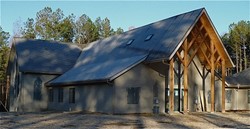When Chapel in the Pines Presbyterian Church was chartered in 2008, it was ready for the next step in its growth — constructing a church building.
The Chapel Hill, N.C., congregation turned to the Presbyterian Investment and Loan Program (PILP) to help make that happen.
One of the six agencies of the Presbyterian Church (U.S.A.), PILP provides low-cost loans to churches and governing bodies for capital projects. Funds for these loans come from PC(USA) endowment funds and money invested by individual Presbyterians, churches and governing bodies.
The Rev. Mindy Douglas Adams, pastor of Chapel in the Pines, knew a bit about PILP and encouraged financial officers at the church to contact the agency.
“I was very happy when they found that PILP was the best deal around,” she said.
PILP works differently from other lending institutions, says Jay Hudson, president and CEO. For one thing, it doesn’t over-lend to churches. PILP works with congregations to size loans and ensure that they don’t get in over their heads. From helping congregations discover how large a project they can take on to helping them understand what it means to take on a loan as a church, PILP works with its borrowers in ways that many banks don’t.
“We really do see our work as a ministry of helping congregations,” Hudson said. “It brings together both the best of business practices and my love for church growth.”
All loans are guaranteed by the presbytery of the church in question, so if the church can’t pay back its loan, the presbytery must do so. Presbyteries rarely pay back entire loans, though they sometimes assume payments for a few months if churches are unable to do so.
Church members can also invest in their congregation’s loan, helping the church earn rebates on the interest they pay. Churches can earn from .25 percent to 1 percent rebates and use the money as they wish, from paying down the loan principle to participating in local mission projects.

The church broke ground in February 2011 and held its first worship in the new building Dec. 11. —Chapel of the Pines
This year, PILP reached $2 million in total rebates from the Get the Point! rebate program, Hudson said. More than 65 percent of eligible borrowers are earning rebates.
Chapel in the Pines is one such church.
“We hope to continue (investing) even as we pay off our loan, to help other new churches,” Adams said. “You’re making an investment.”
Investments have gone up in the past two years, said Ben Blake, PILP’s vice-president of sales and marketing.
PILP is attractive to investors because it pays higher dividends than banks do and offers a spiritual as well as a financial return, Hudson said. Also unlike many banks, PILP is “thriving,” Hudson said. It has just completed its 12th consecutive year where its income has exceeded its expenses.
One challenge facing PILP is staying top of mind with churches, Blake and Hudson said. The average church has a capital project every 20 years, and with leadership changes in congregations, it’s a big task for churches to gain institutional memory about PILP. Like a specialist doctor, churches don’t know that PILP exists until they need it, Hudson said.
That’s where building relationships with mid-councils — who can refer congregations to PILP — comes in. But with upcoming changes in the way those bodies ― presbyteries and synods ― are structured, PILP will be affected and will also probably have less resources to back its loans.
The PC(USA)’s push to form 1,001 new worshipping communities in 10 years will also affect PILP. These communities, which often meet in non-traditional spaces like coffee shops or community centers, are less likely to own property. They are more likely to need loans for renters’ improvements than mortgages, which raises new questions for PILP.
“We’re ready and willing to talk about it,” Hudson said.
For Chapel in the Pines—which celebrated its first worship service in its new building Dec. 11 — working with PILP was a “fantastic” experience, Adams said.
“Because it’s the church, they had a better understanding of who we are and what we’re doing and why we’re doing it,” she said. “I think PILP really has our best interests at heart.”

